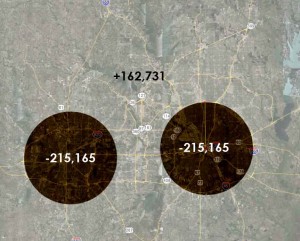Brookings has a new study entitled Job Sprawl. It’s about where job growth (or loss) has occurred between the 2000 and 2010 census. More specifically, whether the gain/loss happened within 3 miles of Central Business Districts (what we once called downtowns before they became increasingly single-purpose glorified office parks, a city’s swan song), whether they happened between 3 and 10 miles, or greater than 10 miles from CBDs.
Here is the interactive feature.
And here is the full PDF report.
And here is a quick map I made to show the critical information:
In the full report, you’ll see that nationally, DFW is the 5th most sprawling metropolitan area (MSA) in the country. Trailing Phoenix, San Antonio, Austin, and Houston. Do any of those places have anything in common? Besides stupid people calling this “growth.”
Brookings only considered Fort Worth and Dallas (primary) as the only two CBDs. DFW lost 215,165 jobs within 10 miles of those respective downtowns, illustrated by the little circles I made. For Dallas, that’s basically everything within 635. Everything else gained 162,731 jobs. This is a bad sign. As I have said, echoing what Jeff Speck wrote in his book, Walkable City, urban cores are competing against their suburbs moreso than they compete against each other. This is what killed Detroit.
Jobs follow housing. Real Estate markets are the invisible hand following the invisible arm of transportation network design. Our transportation agencies actively decentralize our cores. All of them. Even the smaller ones that Brookings didn’t recognize. Yet the market WANTS increased walkability and to reconcentrate for the very purpose humans created cities, for social and economic exchange. To improve quality of life. To experience life and share it with each other. To create wealth. Our transportation planning undermines all of that. ALL. OF. IT.
The result is that everything is further and further apart, requiring people to own cars just to get to work. That’s a tax which sends money out of the local economy, much of it overseas. Then we have to further tax ourselves to build the excessive infrastructure to keep up with the outward expansion and dispersal. Eventually the local economies implode. Again, ask Detroit.
At some point, Dallas and Fort Worth have to stand up to the regional and statewide transportation agencies actively working against them, against main streets, against walkability, and our downtowns. There is a tension between what the market wants and the transportation planning and design working against the market. They’re fighting against each other.
City form follows the prime directive.
*Addendum: I’ve sent an email to the author asking to clarify the methodology. The data shows DFW losing 71,000 jobs, but we’ve gained 1.2 million over that period. This doesn’t make sense unless jobs in relation to population is factored. I’m not exactly sure how that math plays out, but theoretically it seems to make some sense. I’ll post what explanation I receive.







